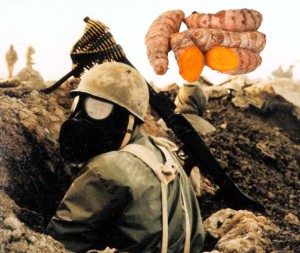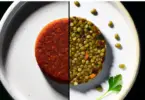26th October 2014
By Sayer Ji
Contributing Writer for Wake Up World
Following closely in the wake of recent revelations that the U.S. government endangered their troops by hiding the discovery of chemical weapons in Iraq, new research shows that turmeric extract may provide an ideal natural intervention to relieve the pain and suffering of sulfur mustard-injured patients.
Recently, the New York Times revealed in an article titled, ‘The Secret Casualties of Iraq’s Abandoned Chemical Weapons,’ that the U.S. government intentionally covered up U.S. troop exposure to chemical weapons in Iraq. You can read the redacted intelligence documents obtained under the Freedom of Information Act.
According to the report:
“From 2004 to 2011, American and American-trained Iraqi troops repeatedly encountered, and on at least six occasions were wounded by, chemical weapons remaining from years earlier in Saddam Hussein’s rule.”
The government kept the discovery secret despite the fact that it endangered U.S. troops:
[pro_ad_display_adzone id=”110028″]
“The American government withheld word about its discoveries even from troops it sent into harm’s way and from military doctors. The government’s secrecy, victims and participants said, prevented troops in some of the war’s most dangerous jobs from receiving proper medical care and official recognition of their wounds.”
Ironically, the ‘weapons of mass destruction’ were built in close collaboration with the West. As reported by Dailykos.com:
“Virtually all of these weapons of mass destruction were from stockpiles established by the Hussein regime during its war with Iran in the 1980s. Many (if not most) of these shells were U.S.-made. And, almost all of them were manufactured in western countries.”
Sulfur mustard is a ‘vesicant chemical warfare agent’ which produces large, extremely painful blisters on exposed skin and lungs. It is classified by the 1993 Chemical Weapons Convention as a Schedule 1 substance, having no use other than for chemical warfare, though a close chemical cousin, nitrogen mustard (known as “HN2”), has been developed for use as chemotherapy in certain blood cancers.
Sulfur mustard was widely used in the Iran-Iraq war with more than 100,000 Iranians exposed, and an estimated one-third of whom are still suffering side effects.[i]
Conventional treatments for mustard gas burns are mainly palliative ones, including pain-killers (e.g. morphine) and steroids (e.g.corticosteroids) (which carry their own serious risks for harm), but research now shows that natural compounds from the spice turmeric known as curcuminoids may provide significant therapeutic value in the treatment of sulfur mustard exposure.
Published recently in the journal Drug Research and titled, “Short-term Curcuminoid Supplementation for Chronic Pulmonary Complications due to Sulfur Mustard Intoxication: Positive Results of a Randomized Double-blind Placebo-controlled Trial,” researchers performed a pilot study, “aimed to investigate the clinical effects of supplementation with curcuminoids on markers of pulmonary function and systemic inflammation in Sulfur Mustard (SM)-intoxicated subjects.”
89 males subjects suffering from SM-induced pulmonary complications were randomly assigned to either a curcuminoid treatment group (500”‰mg TID per oral; n=45) or placebo (n=44) for a period of 4 weeks.
They were tracked for changes by looking at the following parameters:
- Spirometric (meaning the measuring of breath)
- Inflammatory
78 subjects completed the trial. The results were reported as follows:
- The curcuminoid treatment group saw improvement in the FEV1/FVC ratio, indicating improved lung function (specifically the vital capacity to expire air)
- The curcuminoid treatment group saw improvement in all assessed mediators of inflammation, including IL-6, IL-8, TNF α, TGF β, substance P, hs-CRP, CGRP and MCP-1.
The study concluded:
“Curcuminoids were safe and well-tolerated throughout the trial. Short-term adjunctive therapy with curcuminoids can suppress systemic inflammation in patients suffering from SM-induced chronic pulmonary complications.”
Interestingly, this is not the first study to find turmeric compounds have therapeutic value in sulfur mustard associated toxicity. A 2012 study published in the Annals of Clinical Biochemistry found that patients suffering from sulfur mustard induced skin complications experienced significant reductions in inflammation, itching (pruritus) and an overall improvement in quality of life when receiving 1 gram of curcumin daily.[ii] Another 2012 study published in the British Journal of Nutrition found that sulfur mustard-induced chronic skin itching (pruritus) in Iranian veterans could be alleviated with 1 gram a day of curcumin; additionally they found their antioxidant status and quality of life improved significantly. They concluded: “curcumin may be regarded as a natural, safe, widely available and inexpensive treatment for the management of SM-induced chronic pruritus.” [iii]
Clearly, given the limitations of conventional treatment for chemical weapons injury, and given the clinical evidence in support of curcumin, it should be considered a safe alternative – or at least adjuvant – in the treatment of the harms associated with exposure to them.
For additional research on potential natural approaches to chemical weapons injury, take a look at our research page on the topic: Mitigating Chemical Weapons Injury.
For additional research and articles on the benefits of turmeric and its compounds, visit our Health Guide section on the topic: Turmeric research.
Article References
[i] Arthur Shiyovich, Yossi Rosman, Amir Krivoy, Liran Statlender, Michael Kassirer, Shai Shrot. [Long-term complications of sulfur mustard exposure: a therapeutic update]. Harefuah. 2014 Mar-Apr;153(3-4):199-205, 237. PMID: 24791566
[ii] Yunes Panahi, Amirhossein Sahebkar, Shahram Parvin, Alireza Saadat. A randomized controlled trial on the anti-inflammatory effects of curcumin in patients with chronic sulphur mustard-induced cutaneous complications. Ann Clin Biochem. 2012 Nov ;49(Pt 6):580-8. Epub 2012 Oct 4. PMID: 23038702
[iii] Yunes Panahi, Amirhossein Sahebkar, Mojtaba Amiri, Seyyed Masoud Davoudi, Fatemeh Beiraghdar, Seyyedeh Leila Hoseininejad, Marjan Kolivand. Improvement of sulphur mustard-induced chronic pruritus, quality of life and antioxidant status by curcumin: results of a randomised, double-blind, placebo-controlled trial. Br J Nutr. 2012 Oct ;108(7):1272-9. Epub 2011 Nov 18. PMID: 22099425
Further articles by Sayer Ji:
- How WHOLE Turmeric Heals the Damaged Brain
- Fluoridated Water Can Calcify Arteries, Study Finds
- Research – Pineapple Enzyme Kills Cancer Without Killing You
- How Monsanto’s ‘RoundUp’ is Cursing the Global Food Supply
- Garlic Cures 100% of Warts In Clinical Study
- Research Proving Vitamin C’s Therapeutic Value in 200+ Diseases
- Sesame Seeds – Ten Amazing Health Benefits Of This Super-Seed
- Biophotons: The Human Body Emits, Communicates with, and is Made from Light
- 13 Evidence-Based Medicinal Properties of Coconut Oil
- The Spice That Prevents Fluoride From Destroying Your Brain
- Turmeric Beats Ibuprofen for Arthritis of the Knee
About the author:
Sayer Ji is an author, educator, Steering Committee Member of the Global GMO Free Coalition (GGFC), advisory board member of the National Health Federation, and the founder of GreenMedInfo.com – an open access, evidence-based resource supporting natural and integrative modalities. His writings have been published and referenced widely in print and online, including Truthout, Mercola.com, The Journal of Gluten Sensitivity, New York Times and The Well Being Journal.
In 1995 Sayer received a BA degree in Philosophy from Rutgers University, where he studied under the American philosopher Dr. Bruce W. Wilshire, with a focus on the philosophy of science. In 1996, following residency at the Zen Mountain Monastery in upstate New York, he embarked on a 5 year journey of service as a counsellor-teacher and wilderness therapy specialist for various organizations that serve underprivileged and/or adjudicated populations. Since 2003, Sayer has served as a patient advocate and an educator and consultant for the natural health and wellness field.
Visit GreenMedInfo online and on Facebook, or sign up for GreenMedInfo’s e-Newsletter.
[pro_ad_display_adzone id=”110027″]








